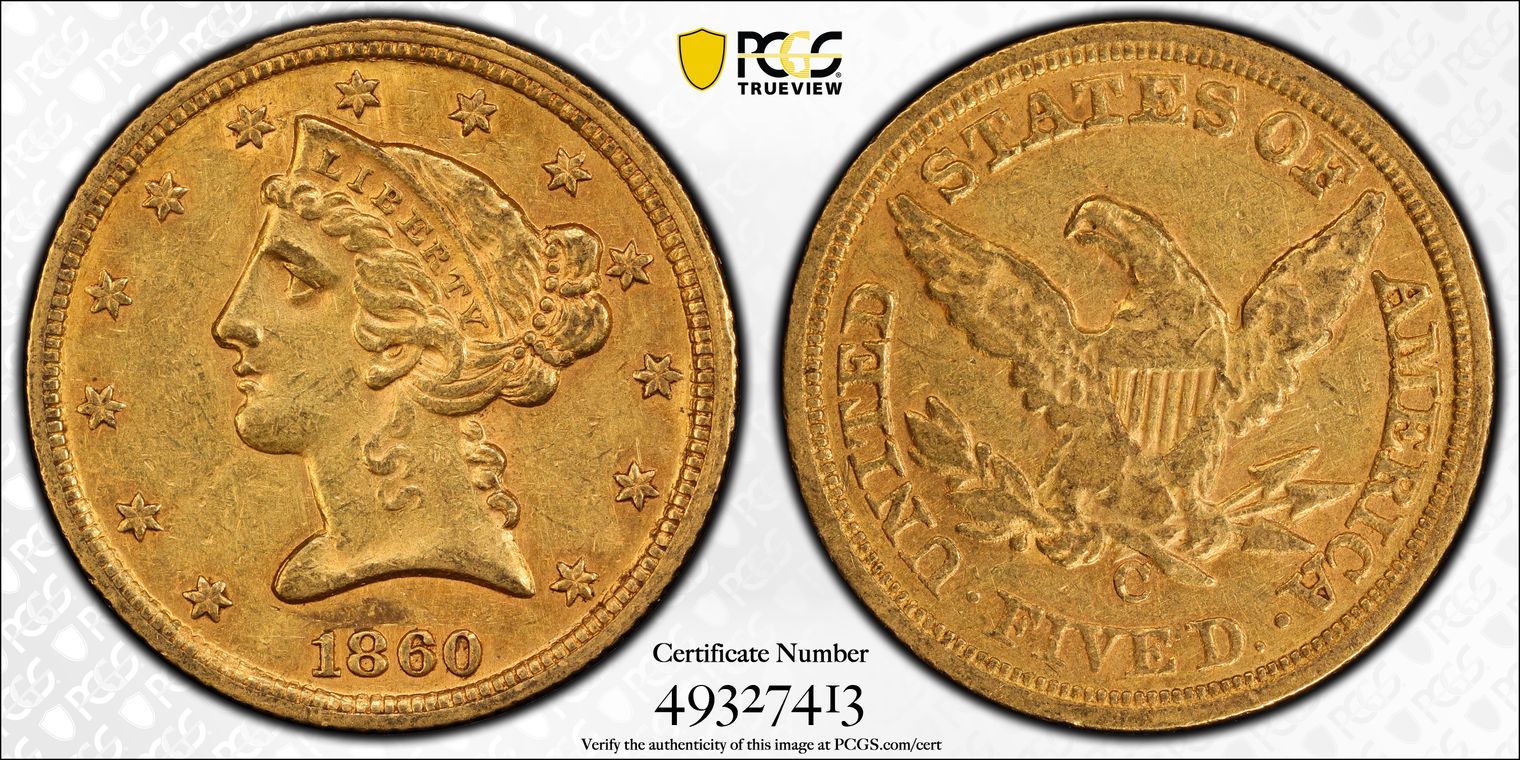1860-C $5 AU53 认证号49327413, PCGS号8285
专家评论
David Akers (1975/88)
The reverses of all 1860-C Half Eagles are very weak, not the result of weak striking or problems with the coinage presses but rather the result of using the same faulty dies as in 1859. The obverses are almost always quite well struck and typically have a sharp rim or partial wire edge. Among Charlotte Mint Half Eagles, the 1860-C has the third lowest mintage but, although fairly rare in all grades, the 1860-C is seen more often in high grade than some other C Mint Half Eagles. Still, the typically available grade is only VF or EF and strictly uncirculated pieces are extremely rare. One variety has a double punched date and is very rare.Doug Winter
Production of half eagles at the Charlotte Mint dropped considerably in 1860. The mintage figure for the 1860-C is the lowest for any half eagle from Charlotte since 1846.The 1860-C half eagle is less rare than its low original mintage figure suggests. Most examples grade Very Fine and Extremely Fine and are characterized by poor eye appeal. This is a scarce issue in the lower About Uncirculated grades and is quite rare in properly graded AU55 to AU58. There are currently around seven or eight Uncirculated coins known, and this includes one or two relatively choice pieces that appear to be new discoveries since the last edition of this book was released a decade ago.
STRIKE: The strike on the 1860-C is similar to that seen on the 1859-C half eagle. The obverse is fairly sharp. All pieces that I have seen have some weakness on the curls around the face and on the top of the curl beneath the ear. The rest of the hair detail is sharp. The stars are bold with many showing full radial lines at the centers. The denticles are also sharp. The reverse is the same as used on the 1859-C. If anything, the lack of detail on the 1860-C is even more pronounced. There is very extensive weakness on the neck of the eagle, the wings and claws, over the shield and on the olive leaves. This makes these details appear very blurry. The borders are sharper with strong lettering and denticles as well as a bold mintmark. After carefully examining a number of examples, I am inclined to think that this reverse was improperly hubbed and, as such, it has an “incomplete” appearance.
SURFACE: Many 1860-C half eagles are strongly striated in the fields. Nearly every example I have seen has clusters of deep marks in the fields, especially on the obverse. The reverse is often seen with numerous detracting marks as well. This is an extremely hard issue to find with choice surfaces and any piece that is not extensively abraded is worth a strong premium.
LUSTER: The luster is typically well below average and most 1860-C half eagles are dull and washed-out in appearance. A few high grade coins are known that have nice frosty luster with a pronounced grainy texture.
COLORATION: The natural color is a light yellow-gold with pale rose and green-gold undertones. I have seen less than a handful that have not been cleaned, dipped or processed at one time.
EYE APPEAL: The eye appeal for this issue can only be judged by the obverse. Most every known example is heavily marked and has inferior luster and color. Many of the higher grade survivors are extensively striated. This is definitely a very hard issue to find with even average quality eye appeal and just a handful of comparably attractive specimens have survived.
DIE CHARACTERISTICS: Most have a curving die defect in the obverse field from the chin down towards the rim between the first two stars. On some higher grade pieces, there are raised die striations that join the seventh star and the coronet.
DIE VARIETIES: There are two varieties known.
Variety 1 (formerly Variety 28-M): The numerals in the date are small and low. The 1 is much closer to the denticles than to the bust. The 0 is much closer to the denticles than to the bust. The reverse is the same as on the 1859-C half eagle.
Variety 2 (formerly Variety 29-M): The date is noticeably double punched with the first punch too far to the left. It was first described by Walter Breen in the June 1957 New Netherlands sale. The reverse is the same as on the 1859-C half eagle.
PCGS #
8285
设计师
Christian Gobrecht
边缘
Reeded
直径
21.65 毫米
重量
8.36 克
铸币数量
14813
金属成分
90% Gold, 10% Copper
更高评级数量
45
评级较低的钱币数量
79
地区
The United States of America
价格指南
PCGS 数量报告
拍卖 - PCGS 评级的
拍卖 - NGC 评级的
稀有性和存量估计 了解更多
| 所有评级 | 450 |
| 60或以上 | 15 |
| 65或以上 | 0 |
| 所有评级 | R-6.1 |
| 60或以上 | R-9.3 |
| 65或以上 | R-10.1 |
| 所有评级 | 94 / 112 TIE |
| 60或以上 | 77 / 112 TIE |
| 65或以上 | 1 / 112 |
| 所有评级 | 133 / 218 TIE |
| 60或以上 | 106 / 218 TIE |
| 65或以上 | 1 / 218 |
状况普查 了解更多
| #1 MS63 PCGS grade |
| #1 MS63 estimated grade |
| #1 MS63 estimated grade |
|
#4 MS62 PCGS grade
Heritage 1/2013:7218, $12,337.50 |
| #4 MS62 PCGS grade |




















